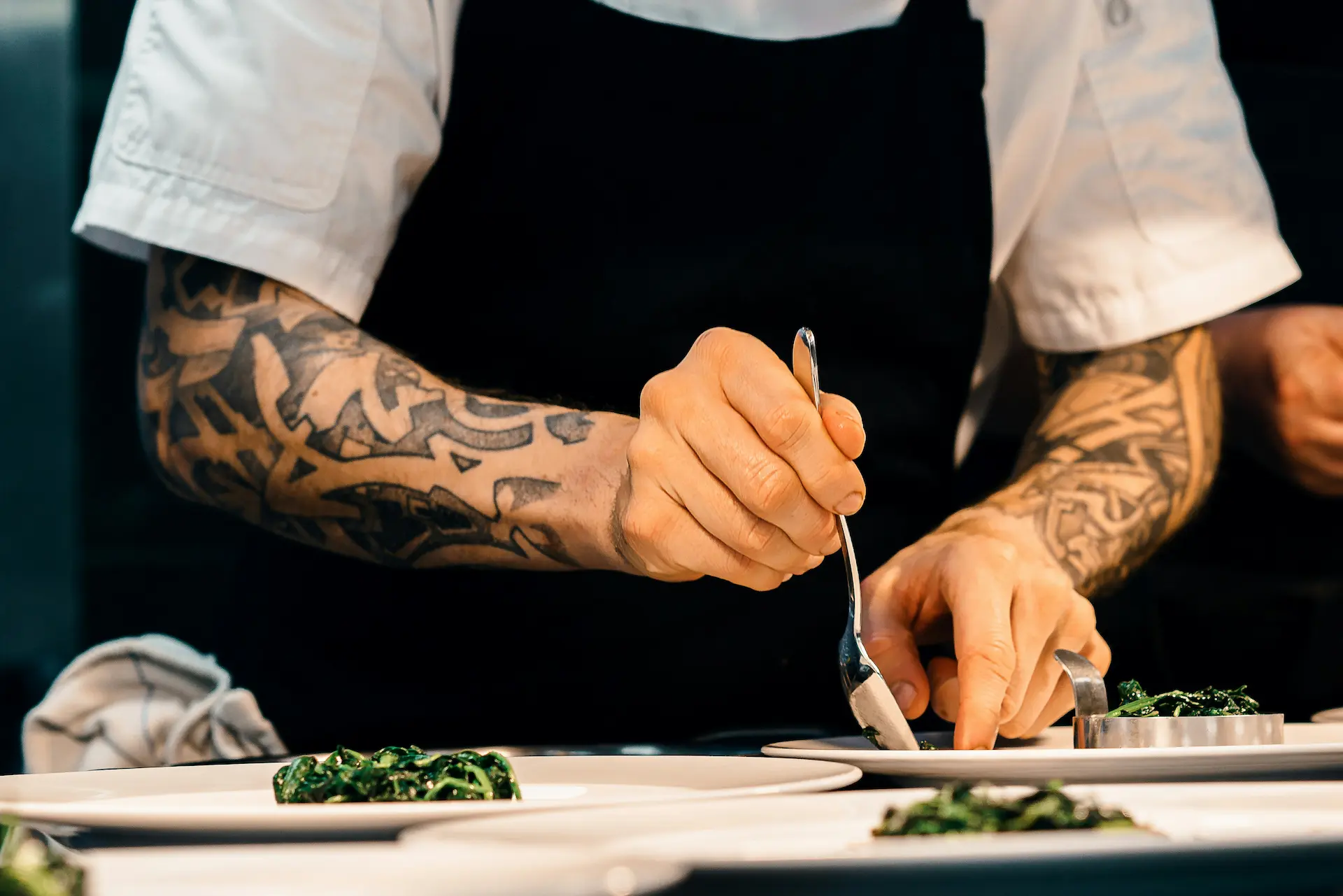
The foundations of exceptional service
1. Train your staff: the pillar of quality service
A well-trained team is the backbone of optimized table service. Staff must understand the stakes of quality service, from communicating with customers to efficient dining room management.
- Continuous Training: Beyond initial training, consider regular workshops to keep staff up-to-date with new service practices and trends.
- Service Manual: Write a clear guide detailing service standards, welcome protocol, dish recommendations, and table setting rules.
- Service Simulation: Organize practical sessions where staff practice different service scenarios, such as conflict management situations.
Thomas Keller, eminent chef, states: "Exceptional service is born from a well-trained team who knows their menu like the back of their hand."
2. Offer a memorable welcome
A Forbes article highlights that businesses with exceptional welcomes see a 20% increase in customer return rates.
The welcome is often the first point of contact with customers, setting the stage for the culinary experience. A careful welcome not only sets the tone for the meal but also imprints the establishment in the memory of your customers.
- Professionalism and Friendliness: Staff should present themselves with a neat appearance and engage each customer with warmth.
- Welcoming Atmosphere: Ensure the reception area offers a warm atmosphere with good lighting and appropriate music.
- Active Listening Training: Train staff to pay attention to needs and preferences, often mentioned immediately during the first interaction.
Optimizing efficiency and speed
Emphasize speed of service
According to Hospitality Management, a 30% improvement in service speed can lead to a 15% increase in customer satisfaction.
Speed of service is fundamental. By optimizing the efficiency of dining room operations, customers will notice a seamless flow in their dining experience, from arrival to the end of the meal.
- Reduce Waiting Times: Analyze the different stages of service to identify bottlenecks and address them.
- Effective Internal Communication: Use a continuous and fluid communication system between the kitchen and the dining room to manage wait times and the flow of dishes.
- Prevent Delays: Train staff to adapt to unforeseen situations to minimize the impact on the customer experience.
Curious to see exactly how Zenchef can transform your restaurant? Try our performance calculator.
Ergonomic dining room layout
Alexandre Bourdas is a pragmatic restaurateur. Since the opening of SaQuaNa ten years ago, he has continuously thought about how to manage the operational aspects of his restaurant more efficiently, particularly in the dining area. "As a Michelin-starred chef, I long pondered the idea of a grand restaurant with decorum. But I'm not sure that comfortable chairs or a 16th-century painting play a significant role in the delightful memories of my customers. With the renovations, I wanted this restaurant to have the grandeur of a large establishment while remaining welcoming, human-sized, and ergonomic."
The design of the dining room should not only reflect aesthetics but also functionality. An ergonomically organized room not only transforms the place into a welcoming space but also facilitates the tasks of the service staff, thereby increasing productivity.
- Furniture Layout: Arrange tables in a way that allows for smooth circulation and creates clear paths for service.
- Use of Sound-Absorbing Materials: Promote an environment where communication is not hindered by ambient noise.
- Flexibility of Space: Opt for modular furniture that can be adjusted according to the size and needs of customer groups, while also providing space for service carts.
Bill Johnson, an interior design expert, notes that "A well-designed space naturally guides the service and enhances the customer experience."
Technology and smart service
Online reservations to allow your service staff to focus on your guests
Using online reservation management software is essential for optimizing service in your restaurant:
- Staff no longer have to manage reservations over the phone, a task that is time-consuming and labor-intensive.
- Your front-of-house teams can focus on the quality of welcome, service, and taking customer orders.
- This tool enhances the customer experience and significantly increases the occupancy rate in your restaurant.
Zenchef offers a reservation management module with no intermediaries or commissions. Installed on your restaurant's website, this management tool allows your customers to make reservations in just a few clicks, 24/7.
Leverage the restaurant menu for efficient service
A detailed knowledge of the menu is a prerequisite for front-of-house staff. This directly impacts their ability to confidently answer questions and recommend dishes.
- Tasting Sessions: Organize regular sessions where staff can taste dishes and discover new culinary creations or variations from the seasonal menu.
- Use of Technical Sheets: Standardize these as a tool to help staff understand preparation times and ingredients for each dish.
A well-informed server not only enhances efficiency but also creates a more authentic connection with the customer, highlighting the team's passion and knowledge.
Harnessing customer feedback
Customer feedback is a valuable compass towards optimal service quality. Analyzing this feedback allows for not only structural modifications but also improvements to existing processes.
- Establish Feedback Systems: Encourage the use of questionnaires or online platforms to collect reviews after each visit.
- Analyze Available Customer Data: Use this data for regular staff meetings to review and discuss areas for improvement.
Jeffrey Gitomer, a customer service expert, states: "Reviews not only signal where you excel but, more importantly, where you have opportunities for improvement."
Digitization and digital ordering
Integrate QR codes and digital menus
According to Statista, 60% of consumers prefer using digital menus for the speed and convenience they offer.
QR codes and other digital technologies have revolutionized how establishments interact with their customers. Providing this option is not only modern but also meets the growing need for accuracy and personalization.
- Facilitating Updates: Allows for easy modifications to menu information, whether reflecting dish availability or prices.
- Increasing Service Efficiency: Reduces the need for physical menu serving, speeding up the ordering process.
Use touchscreen tablets to modernize order taking
Touchscreen tablets are transforming how orders are processed, driving not only speed but also accuracy while adding an interesting layer of interaction for the customer.
- Order Customization: Customers can customize their orders, adding or removing ingredients according to their personal tastes or dietary requirements.
- Minimize Errors: Orders placed directly into the computer system reduce human errors often encountered with paper orders.
Restaurant Dive reports that integrating tablets into the ordering process not only improves customer satisfaction but also reduces order errors by 39%.
Staff management and coordination
Implement an online reservation system
An effective reservation system allows for better forecasting and planning of services. A well-designed module is a tool that facilitates a seamless customer experience while simplifying internal management.
- 24/7 Availability: Accounts for reservations day and night, reducing the need for direct staff engagement.
- Broaden Marketing Impact: Enables customer interaction across various channels, thus increasing the restaurant's reach.
“Online reservations have transformed the customer experience landscape, making what was once a luxury expected,” says an expert from NRN.
Ensure proper staff management
Good human resource management is crucial for ensuring smooth service. Each team member must know their specific role and be aware of collective goals.
- Precise Job Descriptions: Detail responsibilities to avoid confusion and enhance efficiency.
- Motivation and Reward Strategies: Implement systems that encourage and reward excellence, boosting team morale.
Richard Branson, an innovation leader, insists: "Take care of your employees, and they will take care of your customers." A well-managed and motivated team is essential for delivering exceptional service.
The implementation of these strategies will not only enhance the efficiency and speed of your service but also provide a quality experience that will leave a lasting impression on your customers. A well-trained staff, intelligent use of technology, and optimized management will ensure your establishment's long-term prosperity.
Is work attire a key element of service?
To properly welcome your customers, encourage team members to present themselves in clean and pressed work attire and to be patient and understanding in all circumstances. It is also essential to maintain a warm and welcoming atmosphere, with friendly and professional service. A customer who feels well-received will be significantly more likely to return to the establishment and promote it!
Different types of table service: An opportunity to stand out?
An overview of the different types of table service, their protocols, and their functions.
1.Dish-on-table service
Plate service involves placing the dish to the right of each customer, with the serving utensils turned toward them so they can serve themselves. This practice, particularly common in the first half of the 20th century, is mostly used today for host tables and guesthouses wishing to maintain this tradition.
However, this type of service can be utilized in modern dining for specific dishes, such as seafood platters, cheese platters, or when serving mignardises.
2. French-style service
“One should not seek to impose complex gestures, but simply take the time to highlight certain techniques, such as carving beef or serving tartare, which is already done in many chain restaurants. Today, top chefs are looking for ways to stand out from foreign cuisines: reviving French service can be a way to attract attention. In the dining room, customers are often hyper-attentive. With social media, it’s not uncommon for them to even stand up to witness the carving and flambéing done by the head waiter. It’s then essential to succeed in staging. Through my thesis, I aim to understand what 'art of the table and art of service' means and to elevate my profession to the rank of an art of dining gestures,” says Gil Galasso, Best Craftsman of France head waiter.
Codified in the 17th century, French service refers to table service where the front-of-house staff presents dishes directly to diners, who then serve themselves.
However, French service can lead to challenging management if the customer is clumsy, and this self-service may impact the quality of the dish presentation.
In this service style, dishes are served in multiple sequences:
- hors d'oeuvres, starters, and soups first,
- followed by meats, fish, salads, and other savory dishes,
- then vegetables, desserts, and cheeses,
- finally, fruits, desserts, coffee, or digestifs...
French service, the ancestor of buffet service, has fallen out of favor in most restaurants but has the advantage of being a fast service option for large tables.
3. Russian service or guéridon service
Initiated in the 19th century, Russian service, also called "guéridon service," involves placing dishes on a guéridon during service and preparing each plate in front of the guests. Russian service is performed from the left side of the customer (except for wine), and plates are then cleared from the right.
This table service style is suitable for specific dishes, the preparation of which can be staged. This includes flambéed dishes and desserts, as well as the carving of certain meats or serving molecular cuisine.
The service then becomes part of the customer experience, often favored in starred restaurants. However, guéridon service requires highly skilled staff and monopolizes the server longer than a simple plated service, which can significantly slow down table turnover and, consequently, the restaurant's occupancy rate.
4. Plated service or american service
With American service, plates are prepared in the kitchen and brought to the dining room by the server, who places them to the right of the customer. Plated service, or “American style,” is the most common type of service in the hospitality industry.
It is valued for its speed, allowing for good table turnover and facilitating front-of-house staff work, while highlighting the presentation of the dishes on the plate. However, this service requires many back-and-forth trips to the dining room and thus more staff.
5. English service
English service involves bringing meals in their dishes and serving customers from their left, into pre-arranged empty plates. Servers and head waiters fill the plates one by one with their serving utensils (slotted spoon, ladle, serving spoon…). More formal, this type of table service is rarely used in modern dining, although sauces are sometimes served à l'anglaise, independently of the dish.
English service is quick but requires great dexterity from front-of-house staff. It allows many guests to be served at once. However, some dishes cannot be served this way and need to be plated in the kitchen before arriving at the dining room.
6. Cloche plate service in a high-end spirit
Fallen out of favor in most restaurants, cloche plate service involves plating the dishes in the kitchen and then covering them with a metal cloche. The plates are then brought to the dining room by hand or on a tray, sometimes on a service cart, before being uncovered by the server or head waiter at the time of tasting.
Cloche plate service is sometimes done for only certain dishes that the restaurant wishes to highlight, as it offers a beautiful presentation with an element of surprise. Conversely, many prepared dishes cannot be placed under a cloche, risking the degradation of their presentation and flavor.
Counter service: How to optimize it?
Counter service involves offering customers the option to order and pick up their meals directly at the bar of the establishment. It contrasts with traditional table service, where customers wait for the server to take their order.
There is another approach to counter service where the customer places their order at the bar while remaining standing. Once their dish is ready, they pick it up on a tray and head to an available table. This type of service is most commonly used in fast-food establishments: customers place their orders at the counter, wait for their name to be called, and then collect their meals.
Counter service: What are the advantages?
Implementing counter service has numerous benefits for the restaurant, such as:
- Speed : Counter service primarily meets the current expectations of many consumers looking for a quick and quality meal.
- Reduced Waiting Time : Counter service also saves time on order taking and reduces customer waiting times, contributing to increased patronage of the establishment.
- Reduced Staffing Needs : This type of service requires less staff compared to table service, which necessitates a full team of waitstaff.
- Profitability : Counter service helps reduce labor costs and accelerates customer turnover, directly increasing the establishment's profitability.
- Flexibility : While table service is often limited to two services per day, counter service allows for continuous service throughout the day.
Counter service: 5 solutions to optimize it
1. Arrange the counter
It is essential to design the counter to provide a friendly and memorable customer experience. To highlight the counter in your restaurant, adapt it to the layout of the space and place it in a strategic location. To ensure customers dining at the counter are comfortably seated, you can provide ergonomic stools or high chairs.
Furthermore, the length of the bar should be sufficient for dishes and drinks to be arranged without risking interference with neighboring customers. Too much proximity among patrons at the bar can indeed make their dining experience unpleasant.
2. Adapt the recipes
Counter service may also require adapting the offered recipes. Customers dining at the counter are generally in a hurry and expect fast service and quick meals.
Here are some suggestions for quality dishes suited for counter service:
- Gourmet burgers made with quality meats and homemade fries.
- Artisanal tacos filled with fresh, seasonal meats and vegetables.
- Poke bowls presented in colorful bowls with fresh ingredients, raw fish, vegetables, and exotic sauces.
- A varied selection of hot or cold sandwiches, catering to all tastes, from classic ham-and-butter to vegan and vegetarian options.
- Gourmet salads made with fresh ingredients and homemade dressings.
3. Create a friendly atmosphere at the counter
The counter is a lively and bustling area, but the atmosphere should remain conducive to an enjoyable dining experience for the customer.
Here are some ideas for creating a friendly ambiance around this space:
- Implement warm decorations that reflect your restaurant's style and create a friendly atmosphere.
- Pay special attention to lighting, with soft lighting to create a calming ambiance.
- Play soft and pleasant background music.
- Add small details such as fresh flowers, unique menu holders, and appetizers.
- Surround yourself with attentive and smiling staff, ready to engage in friendly conversations with customers seated at the counter.
4. Offer fast good
To optimize counter service in your restaurant, you can also adopt the fast good trend. This concept involves offering balanced dishes, often prepared with local and organic products. These quick and quality meals cater to a growing consumer demand: eating quickly while being mindful of health and the environment.
5. Set appropriate prices for counter service
The prices of dishes served at the counter should also be adjusted to reflect the speed of service and the culinary experience. Therefore, a notable price difference may exist between a restaurant serving exclusively counter dishes and one offering table service meals.













.webp)

.webp)


















.webp)













